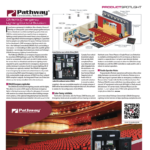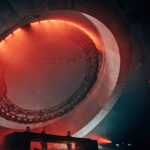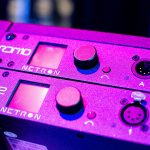Lightronics got their start building dimmers, plain and simple. Founder Kevin Nelson was introduced to theater while a young man in school down in Virginia Beach, where he got involved with the audio and lighting gear he used. Eventually he was hired on by a local music store and got hands on work repairing lighting gear. Along the way he started using gear for shows, working long into the night before loading out his gear and going to the next venue the next day. At a point, he realized that dimmers needed to be constructed a bit more ruggedly to endure the rigors of being travelled in a van and be able to perform consistently every day.
At a young age, Nelson decided to construct dimmers from scratch. Using parts he purchased from Radio Shack, he designed his own dimmer in a garage workshop. Rumor has it this dimmer is still in use today, more than 30 years later, somewhere along the seaside town he resides in. From there, he amassed orders for more dimmers from outside sources and the business grew, forcing a move into a larger facility. They moved on to manufacturing consoles, electronic translators that converted lighting signals to various formats and lighting fixtures as well. While they may have started out by doing live shows, Lightronics noticed that the nightclub vibe in later years was gearing more towards the DJ market. They made a conscious decision to get more involved in the architectural and house of worship markets, and that has turned into a prosperous move for the ever growing company.
Nowadays, Lightronics offers a wide variety of dimmers, ranging from rack mounted modules to portable dimmers to wall mounted models. Dimmers were designed for specific applications with one thing in mind: to make quality equipment that retained its value and continued to work flawlessly. According to the head of marketing, Chris Pease, “Lightronics knew from the very start that they wanted dimmers that could take a beating and remain bulletproof. We have developed a product line that has proven this to be true over the years: our architectural line. Dimmers that can be spec’d for certain applications where there may not have been a variety of dimmers to choose from previously.”
The Dimmers
The main dimmer in their line of AR Series products is a wall-mounted unit called the AR-1202RTC. It contains its own microprocessor as well as 12 x 2.4kW dimmers, each protected by a 20-amp circuit breaker. Dimmer channel semiconductors exceed a 200 percent load carrying capacity overhead allowance. The dimmer is constructed from all UL-recognized components and the internal wiring conforms to the strict standards as well, but keep in mind, it is designed for indoor use only. Each dimmer can be assigned to act as a non-dim circuit as well. The minimum load on each dimmer is 15 watts, so controlling fixtures such as police beacons is easily accommodated.
The dimmer accepts DMX and can be hooked directly up to any light desk that spits that protocol. Lightronics offers a wireless DMX option as well. The dimmers can be soft patched on board. But what separates this module from the older lines of dimmers is that it is smart and can be operated by several types of wall mounted smart remote stations. Smart remotes communicate with the AR-1202 by way of a low voltage RS-485 bus, which is separate from the DMX bus. These remotes are used to bring up scenes that have been preprogrammed in the AR-1202 itself. The user can also operate the dimmers by using momentary switches (simple remotes) to activate these pre-recorded scenes it has saved. One can daisy-chain multiple dimmers together using the RS-485 bus.
Timing and an internal clock are other attributes of this device. One can set scenes to be activated automatically at particular times and dates, which is perfect for architectural use and the timing of lighting for sunrise and sunsets. Up to 100 separate events/scenes can be programmed into the device, with an option to expand to 255 if needed.
Power-wise, it takes 80 amps per leg to run this device at full capacity using 120/208 voltage. Or 120 amps of current, if you run it 120/240 volts single phase. It can operate using just two hot legs of a three-phase system, though this results in an unbalance load and is not recommended on principle. The power setup can be configured easily enough in the field. The rack functions properly on 50/60 hertz. The device is quite simple to install, but keep in mind that it is convection cooled without fans, so leave space between them when mounting. Input power comes in the bottom of the device, and the units are easily wired. DMX and remote control signals come in through the top, and the circuit breakers mount to the sides. Everything is hardwired to terminal strips inside the enclosure. Lightronics also offers a six-channel module called the AR-602RTC.
Also available is the RA series, which consists of a 12-channel rack-mounted device, which can offer either 1200 or 2400 watts per channel. These include the option of running at 230V. Outputs from the back side can be Socapex, stage pin, PowerLock, Edison or terminal strips.

The Expander
New to the offering this year is the AE-4020, referred to as an AR Expansion module. This is an add-on to the AR-1202 model. It provides control for incandescent lighting fixtures and two wire fluorescent lighting ballasts through four separate channels of up to 2400 watts output at 120 volts. It is controlled by an interface with the AR-1202. The AR-1202 uses its four auxiliary channels (13-16 ) to control the AE-4020. While there are individual breakers on the unit, they should not be used as on/off switches. This device should always be hooked up in tandem with the AR-1202 for use.
Fluorescent Ballast Modules
I have never come across a dimmer module specifically designed to be able to control and dim this type of light fixture. But I have blown a few bulbs trying to use conventional dimmers in my time. Lightronics offers the FL4020A and FL-2020 models, which are also add-ons to the AR-1202 model and connect similarly to the Expander module listed above. Dual SCR “zero crossing” switching is used to control the switched hot lines.
The FL4020 can control ballasts through two different versions the company offers. Both methods utilize 120 volts to power the actual fixture, but one will use a dimmed 120 VAC as a control signal, while the other model uses 0-10 VDC for control. The 4020 model offer four channels, each capable of handling 2400 watts of fluorescent dimming. The FL-2020 offers just two channels of the same wattage for people that only require a smaller module for less fixtures.
At a Glance
AR-1202 Wall Mount Dimmer
- Features: 12 channels at 2400 watts each, single or three phase power input, DMX input with soft patch, 100 scenes in memory (w/ options for more), Snapshot recording of scenes, Internal clock/schedule of events. Optional Built in Wireless.
- Size: 20.5” x 21” x 6.25” (WxHxD)
- Weight: 70 lbs.
- MSRP: $3,999
AE-4020 Dimmer Expander Module
- Features: Connects to and adds four more channels to the AR-1202 wall mount dimmer. (AE-2020 is a two-channel model.)
- Size: 18.5” x 15” x 4” (WxHxD)
- Weight: 10 lbs.
- MSRP: $1,295
FL4020A Fluorescent Ballast Module
- Features: Connects to AR1202 and adds four 2400W channels of dimming and control for dimmable fluorescent fixtures.
- Size: 10” x 12” x 4” (WxHxD)
- Weight: 17.7 lbs.
- MSRP: $1,295


